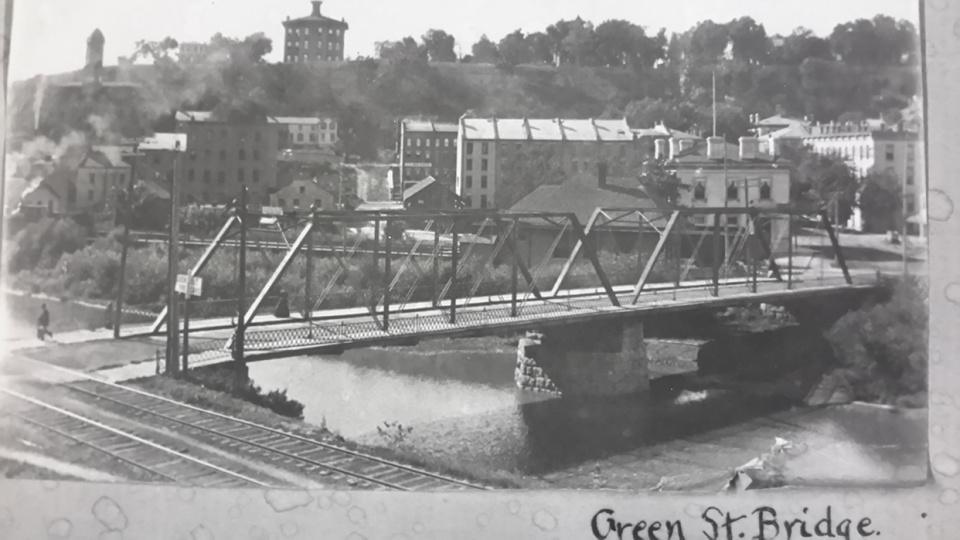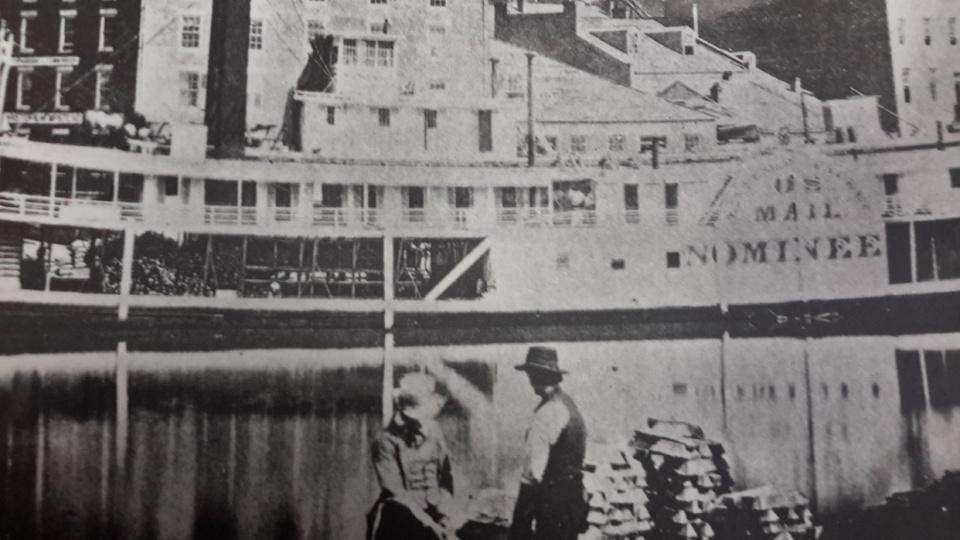In 1822, the first lease in the Fever River country was granted by the federal government to Kentuckian Col. James Johnson, brother of Richard M. Johnson, future vice-President of the United States. He arrived on keelboats with twenty white miners. His mining operations drew much public attention. Soon, would-be miners, mostly frontier farmers from Kentucky and Tennessee, traveled up the Mississippi while those in southern Illinois followed Indian trails.
Seeing the potential, a perceptive Frenchman, Francis Bouthillier, took over a deserted cabin in the mining settlement and started a ferry across the Fever River at the foot of what is now Bouthillier Street.
The first steamboat, the “Virginia,” made it past the rapids at Rock Island in 1823 and ascended the river to Fort Snelling, now St. Paul. This event ushered in a new era for the young lead mine district. Galena soon became the major port and commercial center of the Federal Lead Mine District. Town lots during this early period were leased by the federal government, and, consequently, few permanent buildings were constructed.
Besides the surge for the riches of lead, the river became another major factor in Galena’s growth and prosperity. Originally, it was 265 to 375 feet wide and three to four feet deeper than the main channel of the Mississippi. Large steamboats, some 235 feet in length, would soon be hauling lead down the Mississippi, only to return with more supplies for the growing settlement.
Also in 1823, a businessman from Cincinnati by the name of Moses Meeker arrived on the Fever River. He brought with him 75 tons of mining equipment, provisions, and 43 men, women, and children. He was hoping to use some of the lead in the manufacture of paint. The mineral was a common additive in oil paints, giving them better color and longevity. Lead was also in great demand for musket balls, metal flashing, roofing, leaded glass, pewter, and water pipes.
Galena’s first regular store was built in 1824 by Frederick Dent, father-in-law of General Ulysses S. Grant. By 1825, the settlement had spread out over the hillsides and along the river. It included the settlers, the miners, the Indians, and traveling adventurers. About a thousand people lived in this outpost in temporary cabins, Indian lodges, and shelters of rude construction.
The number of mines increased so rapidly that by 1826, Lieutenant Martin Thomas, leasing agent for the territory, reported to the House of Representatives that the mines had yielded $86,000 worth of lead during that year. However, the log furnaces used by these miners hadn’t improved much over the stone furnaces used by the Indians.
On December 27, 1826, a meeting was held and a majority vote of 30 men, officially and most appropriately, chose to name their town “Galena” after the Latin word for lead sulfide. Also, the John Dowling House and trading post was built, one of Galena’s oldest structures and the first permanent residence in town.
During this time, Galena acquired its first post office, built its first school, and heard its first church services.
However, life in these early mining settlements was rough. A small item in the History of Jo Daviess County, published in 1878, testifies to this fact. Two young boys discovered a rich “lead” near Galena in 1826. However, the claim was jumped by an older man, and an arbitrator was appointed to settle the dispute. He awarded the claim to the boys. The defeated party, being a muscular fellow, declared he would not stand by the decision, but would resort to the law of might. The two young men, instead of going to school the next day, armed themselves and went to their claim. The older man soon appeared, also armed, but after seeing that the boys were serious, he left and never came back! The two boys were brothers, Daniel Smith Harris and Robert Scribe Harris. You will learn more about these famous men in the Bench Street Tour.
Early miners were always worried about the threat of Indian attacks. In 1827, during the Winnebago War, miners became alarmed about threats from the Winnebagos. This so called “war” was actually a minor squabble where two keel boats had been attacked on the Mississippi River by Winnebago warriors. The attack occurred some 200 miles above the Fever River, and several people were killed. This violent event caused the early miners to fear that they could be attacked. Thus, mining operations were temporarily delayed until a treaty was made.
The end of the Winnebago War saw a wild stampede for the Fever River lead mines. The would-be miners were now aided by newer and more powerful steamboats. Soon, restless knots of determined men thronged the levee, anxious to reach the mines and try their fortunes. Prominent among the men who arrived in Galena in 1827 were Hezekiah H. Gear, John G. Houghlett, Horatio Newhall, and Steamboat Captain D.B. Morehouse. You will learn more about these important men throughout your tours.



























